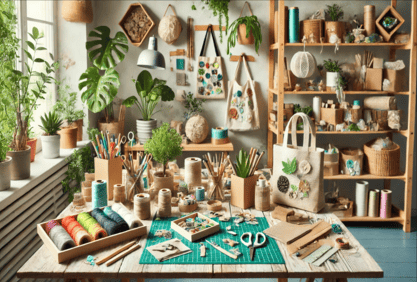Sustainability is no longer just a trend; it’s a necessity for businesses aiming to make a positive impact on the environment. For crafters, adopting sustainable practices not only benefits the planet but also appeals to eco-conscious customers. Here’s a guide to help you build a successful and sustainable craft business.
Why Choose Sustainability?
- Environmental Impact: Reduce waste and conserve resources.
- Market Appeal: Attract eco-conscious consumers who prioritize sustainable products.
- Cost Efficiency: Save money by repurposing materials and minimizing waste.
- Brand Value: Position your business as ethical and forward-thinking.
Steps to Build a Sustainable Craft Business
1. Source Eco-Friendly Materials
Use materials that are kind to the environment and ethically sourced.
- Recycled Materials: Incorporate items like recycled paper, fabric scraps, or reclaimed wood.
- Natural Options: Use biodegradable materials like bamboo, organic cotton, or jute.
- Local Suppliers: Reduce your carbon footprint by sourcing materials locally.
2. Minimize Waste
Adopt practices that help reduce waste during production.
- Upcycle Scraps: Turn leftover materials into new products, such as patchwork items or mini crafts.
- Batch Production: Produce in small batches to avoid overproduction and excess inventory.
- Donate or Recycle: Find ways to donate or recycle materials you can’t use.
3. Design for Longevity
Create durable, high-quality products that customers can use for years.
- Timeless Designs: Focus on classic styles that won’t go out of fashion quickly.
- Repairable Products: Offer repair kits or tutorials for extending the life of your items.
4. Use Sustainable Packaging
Choose packaging that aligns with your eco-friendly values.
- Recyclable Packaging: Use cardboard, paper, or biodegradable materials.
- Minimalist Approach: Reduce packaging to the essentials to minimize waste.
- Encourage Reuse: Provide reusable bags or containers with your branding.
5. Educate Your Customers
Help your audience understand the importance of sustainability.
- Share Your Story: Highlight the sustainable practices and materials used in your business.
- Offer Tips: Educate customers on how to reuse or recycle your products.
- Certifications: Obtain eco-certifications to build trust and credibility.
6. Collaborate with Eco-Friendly Partners
Partner with like-minded businesses or organizations to strengthen your sustainable brand.
- Suppliers: Work with vendors who prioritize sustainability.
- Charities: Donate a portion of your profits to environmental causes.
- Collaborations: Co-create products with other eco-conscious brands.
7. Optimize Your Operations
Adopt green practices throughout your business operations.
- Energy Efficiency: Use energy-saving equipment and LED lighting in your workspace.
- Digital Marketing: Reduce paper usage by focusing on online advertising and communication.
- Remote Work: Operate from home or offer remote work options to reduce commuting emissions.
Tips for Success
- Start Small: Gradually integrate sustainable practices into your business.
- Be Transparent: Share your sustainability goals and progress with your customers.
- Engage Your Audience: Involve customers by encouraging feedback and participation in eco-friendly initiatives.
Conclusion: Crafting with Purpose
Building a sustainable craft business is a rewarding journey that combines creativity, ethics, and environmental responsibility. By adopting eco-friendly practices, you can create products that not only bring joy to your customers but also contribute to a healthier planet. Start today, and let your craft business make a meaningful impact!

